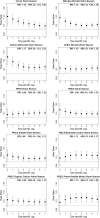Short-term associations between ambient air pollutants and pediatric asthma emergency department visits
- PMID: 20378732
- PMCID: PMC2921597
- DOI: 10.1164/rccm.200908-1201OC
Short-term associations between ambient air pollutants and pediatric asthma emergency department visits
Abstract
Rationale: Certain outdoor air pollutants cause asthma exacerbations in children. To advance understanding of these relationships, further characterization of the dose-response and pollutant lag effects are needed, as are investigations of pollutant species beyond the commonly measured criteria pollutants.
Objectives: Investigate short-term associations between ambient air pollutant concentrations and emergency department visits for pediatric asthma.
Methods: Daily counts of emergency department visits for asthma or wheeze among children aged 5 to 17 years were collected from 41 Metropolitan Atlanta hospitals during 1993-2004 (n = 91,386 visits). Ambient concentrations of gaseous pollutants and speciated particulate matter were available from stationary monitors during this time period. Rate ratios for the warm season (May to October) and cold season (November to April) were estimated using Poisson generalized linear models in the framework of a case-crossover analysis.
Measurements and main results: Both ozone and primary pollutants from traffic sources were associated with emergency department visits for asthma or wheeze; evidence for independent effects of ozone and primary pollutants from traffic sources were observed in multipollutant models. These associations tended to be of the highest magnitude for concentrations on the day of the emergency department visit and were present at relatively low ambient concentrations.
Conclusions: Even at relatively low ambient concentrations, ozone and primary pollutants from traffic sources independently contributed to the burden of emergency department visits for pediatric asthma.
Figures



Comment in
-
Air pollution, population vulnerability, and standards for ambient air quality.Am J Respir Crit Care Med. 2010 Aug 1;182(3):296-7. doi: 10.1164/rccm.201004-0538ED. Am J Respir Crit Care Med. 2010. PMID: 20675677 No abstract available.
References
-
- US EPA. Air quality criteria for particulate matter (final). Washington, DC: US Environmental Protection Agency 600/P-99/002aF-bF; 2004.
-
- US EPA. Air quality criteria for ozone and related photochemical oxidants (final). Washington, DC: United States Environmental Protection Agency EPA/600/R-05/004aF-cF; 2006.
-
- World Health Organization. Health aspects of air pollution: Results from the WHO project “systematic review of air pollution in Europe.” Copenhagen, Denmark: WHO Regional Office for Europe; 2004.
-
- Bateson TF, Schwartz J. Children's response to air pollutants. J Toxicol Environ Health A 2008;71:238–243. - PubMed
-
- Selgrade MK, Plopper CG, Gilmour MI, Conolly RB, Foos BS. Assessing the health effects and risks associated with children's inhalation exposures: asthma and allergy. J Toxicol Environ Health A 2008;71:196–207. - PubMed
Publication types
MeSH terms
Substances
LinkOut - more resources
Full Text Sources
Medical
Miscellaneous

